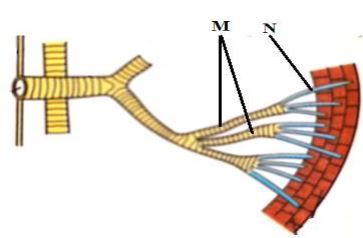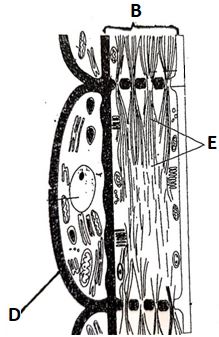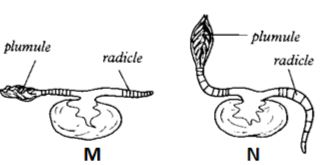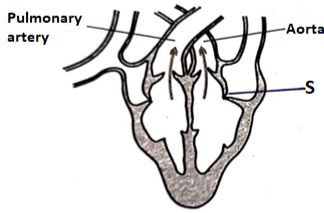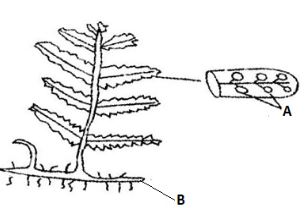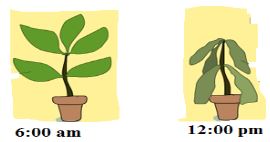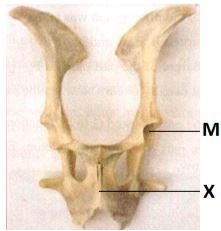-
- Photosynthesis takes place in two stages. Name the part of the chloroplast where the light stage occurs. (1mark)
- How is the dark stage dependent on the light stage of photosynthesis (2marks)
-
- Name the enzyme that speeds up transport of Carbon (IV) Oxide in the red blood cells. (1 mark)
- Explain the role of haemoglobin in transport of Carbon (IV) Oxide in the body. (2 marks)
-
- Explain why excessive use of pesticides in the soil lowers concentration of nitrates. (1 mark)
- It has been observed that 1000 wild animals including giraffes, Lions, zebras and hyenas can occupy 10 acres of land without depletion of the available food. However, 1000 cattle will deplete the available resources in the same piece of land. Explain. (2 marks)
- The illustration below represents the base sequence of a section of a nucleic acid.
-
- Identify the nucleic acid whose section is represented by the illustration. (1 mark)
- Give a reason for your answer in (a) (i). (1 mark)
- Name the part of the cell where the section of the nucleic acid shown would be used. (1 mark)
-
- The diagram below shows part of the gaseous exchange system of a given animal.
- What is the importance of the bands of chitin observed in the part labelled M? (1 mark)
- How is the part labelled N adapted to it`s function. (2marks)
- The paddles of a whale and the fins of fish are both used for swimming in water.
-
- Name the evolutionary phenomenon that may have given rise to the two structures. (1 mark)
- What name is given to such structures? (1 mark)
- Give one example of a vestigial structure in human beings. (1 mark)
-
- Below is a diagram of a plant tissue. Use it to answer the questions that follow.
- Identify the tissue. (1 mark)
- Name the specialized cell marked B. (1 mark)
- Explain how the parts labelled D and E adapt the tissue to their functions. (2 marks)
D
E
- State the functions of the following parts of a tooth.
- Enamel. (1 mark)
- Pulp cavity. (1 mark)
- State and explain what happens to the thigh muscles in case of oxygen debt when one is running. (2marks)
-
- Name the method by which the following excretory products are removed from plants.
- Excess water....................... (1 mark)
- Carbon (IV) Oxide from respiration......... (1 mark)
- Identify the plant excretory product obtained from raw paw paw fruits and used as a meat tenderizer. (1 mark)
- Name the method by which the following excretory products are removed from plants.
- An experiment was carried out to study the effect of pH on hydrolysis of starch by saliva.
The results are shown in the table below.
Test tube pH Time taken (Min) 1 8 1 2 7 4 3 6.5 12 4 6 10 5 3 - At what PH value was hydrolysis of starch most rapid? (1 mark)
- What is likely to be the time taken to hydrolyse starch in test tube 5. (1mark)
- Starch is hydrolysed by Ptyalin present in the saliva. Explain why the activity of ptyalin stops in the stomach. (2marks)
- Explain how the human sperm cell is structurally adapted to perform its function. (2marks)
- In an experiment, a seedling was placed in a horizontal position as shown if figure M below. After 48 hours, the set up was as shown in figure N.
- Name the response exhibited by the radicle of the seedling. (1 mark)
- Explain how the plumule formed a curvature upwards. (3 marks)
-
- If fruit flies with broad abdomens were crossed with those having narrow abdomens, all the offspring in F1 generation had broad abdomens. Using letter A to represent the gene for abdomen size, write the genotypes of the parents. (2 marks)
- In the F2 generation, 150 fruit flies had narrow abdomens. How many fruit flies with broad abdomen were in the same generation? (Show your working) (2 marks)
- The diagram below shows a state of the mammalian heart during a heartbeat.
-
- Identify the stage of the heart beat cycle illustrated in the diagram. (1 mark)
- Give two reasons for your answer. (2 marks)
- Name the valve labelled S. (1 mark)
-
- The diagram below represents a fern plant.
- To which division does the plant belong? (1 mark)
- Name the parts labelled A and B. (2 marks)
- Give two differences between a fern plant and a moss plant. (2 marks)
Fern plant Moss plant
- During germination of seeds, there is production of heat.
- Name the process that leads to heat production in the seeds. (1 mark)
- Describe how heat is produced by germinating seeds. (3 marks)
- Below are photographs of plants taken at different times of the day.
- Give a term used to describe the nature of cells obtained from the plant at:
- At 6.00am (1 mark)
- At 12.00pm (1 mark)
- Explain the significance of drooping of leaves in plants. (2 marks)
- Name the tissue that provides support in herbaceous plants. (1 mark
- Give a term used to describe the nature of cells obtained from the plant at:
-
- Apart from protection of underlying tissues, give two other functions of the mammalian skin. (2 marks)
- Explain what makes the cornified layer of the skin to offer protection against mechanical injury. (1 mark)
- Name two mechanisms that hinder self-fertilization in flowering plants. (2 marks)
- Explain why growing grass dies a few days after salt is sprinkled on it. (2 marks)
- List three differences between the nervous system and endocrine system. (3 marks)
Nervous system Endocrine system - Name the tissue in plants that carries out the following functions:
- Leads to primary growth. (1 mark)
- Manufacture of food. (1 mark)
- The diagram below represents a mammalian bone from the appendicular skeleton.
- Identify the bone (1 mark)
- State the function of the part labelled M. (1 mark)
- Explain how the part labelled X is adapted to its function. (2 marks)
- Give three functions of diffusion in living organisms. (3marks)
MARKING SCHEME.
-
- Granum; Acc. Grana.
-
- Uses Hydrogen ions formed in the light stage (for CO2 fixation);
- Uses ATP/energy from the light stage;
-
- Carbonic anhydrase;
- It combines with CO2 to form carbaminohaemoglobin; which is transported to the lungs where it dissociates to releases CO2 that is exhaled; It combines with hydrogen ions from dissociation of carbonic acid hence acts as a buffer;
-
- The pesticides kill nitrogen fixing bacteria(that convert atmospheric nitrogen to nitrates);
- The wild animals exploit different ecological niches//exploit different sources of food; but the cattle are mainly grazers;
-
-
- m-RNA; Acc. RNA
- Presence of Uracil; Rej. Absence of Thymine.
- Ribosome//Cytoplasm;
-
-
- Keep the structure open//Prevent it from collapsing;
-
- Thin walled for faster diffusion of the respiratory gases;
- Moist inner lining to dissolve the respiratory gases; Rej. Numerous & higly vascularised
-
-
- Convergent evolution;
- Analogous structures;
- Appendix//Coccyx;
-
-
- Phloem (tissue);
- Sieve tube;
- Explain how the parts labelled D and E adapt the tissue to it`s function. (2marks
- D − Has numerous mitochondria to provide energy for translocation;
- E − Provide channels along which food substances are moved from one sieve tube to the next;
-
- Enamel
- Protects the dentine//inner parts from mechanical injury;
- Provides a hard surface for biting//grinding food; (Mark any one)
- Pulp cavity
- Contains nerve endings for sensitivity//to detect pain/heat/cold;
- Contains blood vessels that transport nutrients to the living cells of the dentine//that remove metabolic wastes from the cells of the dentine;
- Enamel
- Muscle cramps/pain occurs; due to accumulation of lactic acid in the muscle;
-
-
- Transpiration;
- Diffusion;
- Papain;
-
-
- Test tube 1;
- Any value above 12 (12-15);
- Ptyalin functions best in an alkaline medium; hence it is denatured by HCL/acidity in the stomach;
-
- The head has acrosome that contains lytic enzymes which digest the membranes of the ovum for penetration;
- Has a haploid nucleus that fuses with that of the ovum during fertilization//Has a haploid nucleus that carries genetic materials;
- Has numerous mitochondria which provide energy for movement;
- Has a long tail for propulsion; (MARK ANY THREE.)
-
- Positive geotropism;
- Gravity causes high auxin concentration on the lower part of the shoot; this leads to rapid elongation of cells on the lower part than the upper part; making the shoot to curve upwards;
-
- AA; aa;
- Total No.of in F2 flies = 150 x 4 = 600;
With broad abdomen = ¾ x 600 = 450;
-
-
- Systole;
-
- Atrio-ventricular valves closed; Acc. Tricuspid and Bicuspid valves closed.
- Semi-lunar valves open;
- Bicuspid valve;
-
-
- Pteridophyta;
- A - Sori;
B - Rhizome; -
MARK 1ST TWOFern plant Moss plant i) Has compound leaves i)Has simple leaves; ii) Has adventitious roots ii) Has rhizoids; iii) Has a vascular system//Xylem & Phloem iii) Lacks vascular system; iv) The sporophyte generation is the dominant form; iv) Gametophyte generation is dominant/persistent;
-
- Respiration;
- Starch stored in the endosperm is hydrolysed to glucose; glucose is then transported to radicle and plumule; where it is oxidized//broken down to yield energy for growth;
-
-
- Turgid;
- Flaccid;
- It reduces the surface area of the leaf exposed to the environment; hence decreases transpiration rate;
- Parenchyma;
-
-
-
- Excretion (of excess water & salts);
- Regulation of body temperature;
- Reception of stimuli//Sense organ;
- Synthesis of vitamin D;
- Storage fats; MARK 1ST TWO.
- Consists of dead keratinized cells;
-
-
- Self sterility;
- Protandry;
- Protogyny;
- Heterostyly;
- Dioecism; MARK 1ST TWO.
- Salt exerts osmotic pressure and draws water from the cells of the grass by osmosis; further water loss dehydrates the cells and kills the plant;
-
MARK 1ST THREE.Nervous system Endocrine system i) A nerve impulse causes a response i) A chemical/Hormone causes a response; ii) The impulse is transmitted through a nerve fibre ii) The chemical/Hormone is transmitted through blood; iii) The impulse is transmitted to a specific part of the body iii) Hormones reach all parts of the body; iv) Responses are usually fast iv) Responses are usually slow; v) Effects are short lived v) Effects are long lasting; vi) Response may take place voluntarily or involuntarily vi) Response takes place involuntarily; -
- Apical meristem;
- Palisade (tissue);
-
- Pelvic girdle;
- Articulates with the head of femur bone (forming a ball & socket joint);
- Has cartilage that can stretch/expand to allow widening of female pelvic girdles during birth;
-
- For gaseous exchange in plants and animals;
- Translocation//Transport of manufactured food in plants;
- Absorption of digested food in the gut;
- Absorption of some mineral salts//ions by the roots; MARK 1ST TWO.
Download Biology Paper 1 Questions and Answers - BSJE Mock Exams 2023.
Tap Here to Download for 50/-
Get on WhatsApp for 50/-
Why download?
- ✔ To read offline at any time.
- ✔ To Print at your convenience
- ✔ Share Easily with Friends / Students


